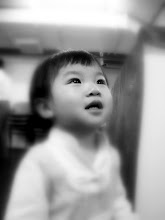The author of Hebrews is going to present to his readers the ‘main point’ of his sermon in verse 1 of chapter 8. Though the original Greek word of it can also mean ‘summary’ or ‘to sum up’, I think he is really wanting only to highlight the ‘main point’. And as a preacher myself, I have learned that, in preaching, the main thing is to keep the main thing the main thing. So, the main point here is to keep the main point the main point! So, what the main point? Jesus, the better high priest has something better to offer (v3).
As I read on today’s passage, I am puzzled by the ‘something’ which Jesus can offer better. What is this ‘something’? Then, I am being drawn to the word ‘copy’ in verse 5. Jesus is a not a copy, He is the real thing! But verses 4 and 5 inform us that what Jesus is doing in heaven can be seen also on earth. The author of Hebrews has a very clear picture of heaven reality being acted out on earth. Perhaps, this is what some commentators call it: Platonic idea. I think Leon Morris commentary on verse 5 will give us a good understanding:
The earthly priests serve in a sanctuary they value highly, though it is no more than "a copy and shadow of what is in heaven." There has been much discussion as to how "Platonic" this idea is. Some remind us that Plato thought of heavenly "ideas" as the archetypes of all things earthly. They think that the author has used the thought of an earthly sanctuary as no more than the imperfect actualization of a Platonic heavenly sanctuary. Others point out that the idea of heavenly counterparts of earthly objects was widespread. For example, we read of the heavenly temple in the Testament of Levi (T Levi 5:1) and in Wisdom 9:8, which says, "Thou hast given command to build a temple on thy holy mountain, and an altar in the city of thy habitation, a copy of the holy tent which thou didst prepare from the beginning."
There can be no question but that there is enough of the heavenly counterpart concept in Jewish sources for us to maintain that the author need not have been dependent on Plato. However, he does not say that the earthly was an exact copy of the heavenly, as the rabbis apparently did. There is a good deal to be said for the idea that his language is that of the Alexandrian modification of Platonism. This does not mean that he is using the distinction out of strong philosophic views but that he is using popular terminology with such associations. His main thought accords with the OT model, though he adds the idea that the earthly is but imperfect. It is the heavenly that is real. Inevitably the ministry of the Levitical priests was defective; they could serve only the "copy and shadow." So we are reminded of the Lord's words to Moses that he must make everything "according to the pattern shown [him] on the mountain" (Exod 25:40). The rabbis often appealed to the Mosaic example (see SBK pp. 702-4). For example, they said, "An ark of fire and a table of fire and a candlestick of fire came down from heaven; and these Moses saw and reproduced" (Tal Menahoth 29a; the passage goes on to affirm that Moses did this "after their pattern" and not merely "according to the fashion thereof").
But whatever it is, Jesus is the real thing; His ministry is more excellent (v6). And whatever we have in the past (referring to the Old Testament’s covenants, tabernacle and even high priest) are merely a copy of the real thing, Jesus who has come and done.
The copy can only give us a fore-taste of the real thing. I have some miniature kitchen set at home for my little girl to play with. She will pretend to cook, using a spoon to do some stir frying in a pan then she will bring the pan together with the spoon and give me to eat. For a long time, I am puzzle where she learns stir frying from? She does get into the kitchen when her grandmother is cooking. After awhile, I realize she is not mimicking stir frying; she is mimicking the way we bring out her porridge to feed her. We will stir the porridge to cool it, and then bring it to her to feed her. This is the real thing she is copying!
When we look at the copy, we may not fully understand the real thing; but now, we have the real thing! And yesterday, as we celebrated Easter Sunday, I was reminded of the real thing. I was reminded the real High Priest, I was reminded of the real Sacrifice on the Cross, and I was reminded of the real promise of God; that is the real deal! Do you copy that?
HHS…
Abel…


No comments:
Post a Comment